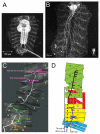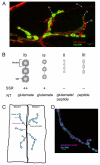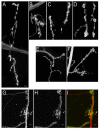Development and plasticity of the Drosophila larval neuromuscular junction
- PMID: 24014452
- PMCID: PMC3767937
- DOI: 10.1002/wdev.108
Development and plasticity of the Drosophila larval neuromuscular junction
Abstract
The Drosophila larval neuromuscular system is relatively simple, containing only 32 motor neurons in each abdominal hemisegment, and its neuromuscular junctions (NMJs) have been studied extensively. NMJ synapses exhibit developmental and functional plasticity while displaying stereotyped connectivity. Drosophila Type I NMJ synapses are glutamatergic, while the vertebrate NMJ uses acetylcholine as its primary neurotransmitter. The larval NMJ synapses use ionotropic glutamate receptors (GluRs) that are homologous to AMPA-type GluRs in the mammalian brain, and they have postsynaptic scaffolds that resemble those found in mammalian postsynaptic densities. These features make the Drosophila neuromuscular system an excellent genetic model for the study of excitatory synapses in the mammalian central nervous system. The first section of the review presents an overview of NMJ development. The second section describes genes that regulate NMJ development, including: (1) genes that positively and negatively regulate growth of the NMJ, (2) genes required for maintenance of NMJ bouton structure, (3) genes that modulate neuronal activity and alter NMJ growth, (4) genes involved in transsynaptic signaling at the NMJ. The third section describes genes that regulate acute plasticity, focusing on translational regulatory mechanisms. As this review is intended for a developmental biology audience, it does not cover NMJ electrophysiology in detail, and does not review genes for which mutations produce only electrophysiological but no structural phenotypes.
Copyright © 2013 Wiley Periodicals, Inc.
Figures






Similar articles
-
Identification of Mob2, a novel regulator of larval neuromuscular junction morphology, in natural populations of Drosophila melanogaster.Genetics. 2013 Nov;195(3):915-26. doi: 10.1534/genetics.113.156562. Epub 2013 Aug 26. Genetics. 2013. PMID: 23979583 Free PMC article.
-
Structural and Functional Synaptic Plasticity Induced by Convergent Synapse Loss in the Drosophila Neuromuscular Circuit.J Neurosci. 2021 Feb 17;41(7):1401-1417. doi: 10.1523/JNEUROSCI.1492-20.2020. Epub 2021 Jan 5. J Neurosci. 2021. PMID: 33402422 Free PMC article.
-
The Roles of the Numb Protein in Synaptic Development and Plasticity.Dev Neurobiol. 2025 Jul;85(3):e22988. doi: 10.1002/dneu.22988. Dev Neurobiol. 2025. PMID: 40620134
-
Transmission, Development, and Plasticity of Synapses.Genetics. 2015 Oct;201(2):345-75. doi: 10.1534/genetics.115.176529. Genetics. 2015. PMID: 26447126 Free PMC article. Review.
-
Synaptic development: insights from Drosophila.Curr Opin Neurobiol. 2007 Feb;17(1):35-42. doi: 10.1016/j.conb.2007.01.001. Epub 2007 Jan 16. Curr Opin Neurobiol. 2007. PMID: 17229568 Review.
Cited by
-
Postsynaptic Syntaxin 4 negatively regulates the efficiency of neurotransmitter release.J Neurogenet. 2018 Sep;32(3):221-229. doi: 10.1080/01677063.2018.1501372. Epub 2018 Sep 3. J Neurogenet. 2018. PMID: 30175640 Free PMC article.
-
Intellectual disability and autism spectrum disorders 'on the fly': insights from Drosophila.Dis Model Mech. 2019 May 13;12(5):dmm039180. doi: 10.1242/dmm.039180. Dis Model Mech. 2019. PMID: 31088981 Free PMC article. Review.
-
Drosophila mRNA Localization During Later Development: Past, Present, and Future.Front Genet. 2019 Mar 7;10:135. doi: 10.3389/fgene.2019.00135. eCollection 2019. Front Genet. 2019. PMID: 30899273 Free PMC article. Review.
-
Dscam2 suppresses synaptic strength through a PI3K-dependent endosomal pathway.J Cell Biol. 2020 Jun 1;219(6):e201909143. doi: 10.1083/jcb.201909143. J Cell Biol. 2020. PMID: 32259198 Free PMC article.
-
SynLight: a dicistronic strategy for simultaneous active zone and cell labeling in the Drosophila nervous system.bioRxiv [Preprint]. 2023 Jul 17:2023.07.17.549367. doi: 10.1101/2023.07.17.549367. bioRxiv. 2023. Update in: G3 (Bethesda). 2023 Nov 1;13(11):jkad221. doi: 10.1093/g3journal/jkad221. PMID: 37502901 Free PMC article. Updated. Preprint.
References
-
- Tabuchi K, Sudhof TC. Structure and evolution of neurexin genes: insight into the mechanism of alternative splicing. Genomics. 2002 Jun;79(6):849–859. - PubMed
-
- Banovic D, Khorramshahi O, Owald D, et al. Drosophila neuroligin 1 promotes growth and postsynaptic differentiation at glutamatergic neuromuscular junctions. Neuron. 2010 Jun 10;66(5):724–738. - PubMed
Publication types
MeSH terms
Substances
Grants and funding
LinkOut - more resources
Full Text Sources
Other Literature Sources
Molecular Biology Databases
Research Materials

